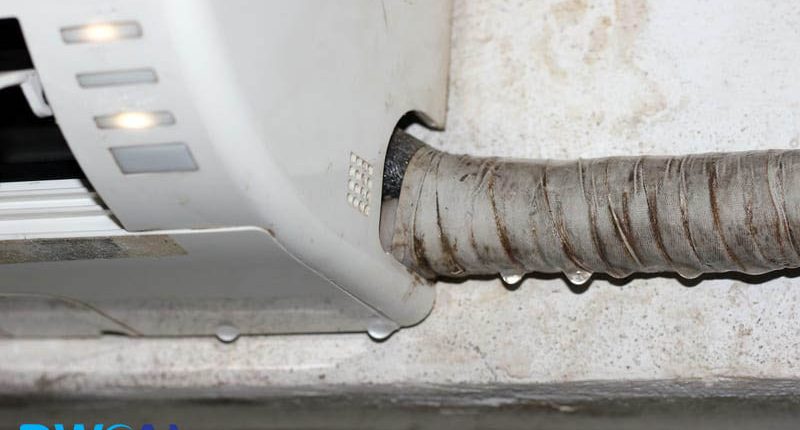What is the Jelly Like Substance in My Air Conditioner?
Dust-loving bacteria and other microbes, which frequently thrive in damp and dark places within your air conditioner, are shielded by the jelly-like fluid which builds up in your air conditioner. These consist of the drip pan, condensate pump, drain lines, and many more parts of your air conditioner. Even though this jelly can appear to be rather harmless, leaving it inside your air conditioner can lead to several problems, such as the following:
- If this jelly is not removed, it may obstruct the drain line of your air conditioner, causing unwelcome leaks.
- Additionally, this jelly may hinder the air conditioner’s ability to remove condensation, which may drive water back into the unit and impair its capacity to cool and function.
- Additionally, the jelly may encourage the formation of mould and mildew, which might seriously endanger your health and the health of those you love.
Indications That Slime Is The Culprit:
Slime in the system can be the cause of water dripping from your air conditioner. To determine whether slime is present, look for these indicators:
- Water Leak: If there is a lot of water collecting around your air conditioner, it may be a sign that the condensate system is clogged.
- Foul Odors: The presence of bacteria and mould in the system is sometimes accompanied by a musty or disagreeable odour.
- Diminished Efficiency: A build-up of slime can cause your unit’s airflow and efficiency to decrease, resulting in lengthier cooling cycles and greater energy costs.
- Visible Slime: Look for obvious indications of slimy residue or discolouration in the drip pan or drain line.
- Mould Development Nearby: Mold around the unit or close to the air vents may be a sign of extensive microbial development in the system.
How Does Air Conditioner Slime Form?
Condensation is the first step in slime production in air conditioners. Your air conditioner extracts moisture from the air as it cools heated air, which then gathers in a drip pan and exits through the condensate drain line. Over time, the organic material, dust, and moisture in these places provide the perfect conditions for the growth of bacteria and fungi.
The organic particles in the condensate water are consumed by bacteria and mould, which grow quickly and create the biofilm that we know as slime. This slime accumulates and begins to obstruct the condensate water flow if it is not cleaned on a regular basis, leading to leaks and other problems.
Other Reasons For Why Slime is to Blame:
· Blockage of Microbes in the Drain Line:
Bacteria and fungi can produce slime, which can progressively accumulate and clog the condensate drain line in a heavy, sticky blockage. Water backs up and eventually leaks out of the system as a result of this improper water drainage.
· Build-Up Within The Drip Pan:
Your system’s water condensation is collected by the drip pan. Slime builds up in the pan over time, decreasing its ability to retain water. Because of this, adding even a tiny bit more water can make the pan overflow and spill onto your floor.
· Component Corrosion:
Slime’s microbiological and organic composition may cause chemical reactions with metallic components in the drip pan or drain line. Water may leak where it shouldn’t because of holes or structural weakness caused by this corrosion.
· Higher Levels of Humidity:
The system’s capacity to efficiently regulate humidity may be compromised by slime growth. Increased condensation from higher system humidity overwhelms the drainage system and causes leaks.
· Temperature Variations Make the Issue Worse:
The fluctuating temperatures in the condensate line caused by your air conditioner’s on/off cycles might exacerbate slime issues. Slime forms and obstructs the line during colder temperatures; it softens during warmer temperatures, causing partial drainage and blockages.
· Dust and Debris Are Attracted to Slime:
Dust, cat hair, and other waste that circulates through your HVAC system are drawn to slime. This raises the possibility that the drain line may become clogged, increasing the likelihood that water will back up and leak from your unit.
· Condensate Pump Impact:
Slime can interfere with the operation of a condensate pump in your system. Dripping problems and spills could result from the pump being clogged or ineffective at water that circulates.
· Airborne Slime Particles:
When slime builds up in your air conditioner, tiny particles may fly into the air and land in other parts of the system. These particles have the potential to create more obstructions and contribute to dripping in unexpected places, like close to ducting or vents.
· Increased Water Surface Tension:
By raising the water’s surface tension, slime modifies the water’s movement and makes it harder for it to pass easily through the drain line. Pooling and eventual leakage are the result of this.
· Multiplication of Mold and Mildew:
Mould and mildew frequently develop alongside or are encouraged by slime. These extra pollutants worsen clogging problems, lower air quality, and raise the risk of leaking and inefficient systems.
· Drain Line Structural Deformation:
The inside surfaces of the drain line may get deformed or lose their smoothness as a result of an extended slime accumulation. Clogs and drips become more common as a result of the increased friction and resistance to water flow caused by this.
By addressing these fundamental causes, you will gain a better understanding of how slime dramatically affects your air conditioner and why regular maintenance is necessary to avoid leaking and other associated issues.


